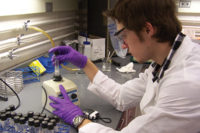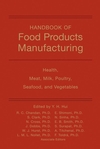Nevertheless, there is a much more simplistic use for the principals of process control in the management of food safety not related to detailed data capture.
When we discuss process control, we are attempting to control the outcome of a system or process to a pre-determined level. This approach can and is used in simple manufacturing systems, such as basic good manufacturing practices (GMPs), as well as plant cleaning systems.
West Liberty Foods is an advocate for developing manufacturing facilities and systems to make GMP and food-safety compliance easier. We believe that this approach to food-safety systems delivers far better results; and the management of these systems is easier with employee compliance being much more consistent.
What do we mean by setting up plants and manufacturing systems with food-safety process control in mind? During initial planning of facility design or manufacturing systems, separation is key in making procedure compliance simple. This includes limiting access points into ready-to-eat (RTE) product areas, controlling the movement of people through physical separation, and having physical barriers to limit the exposure of product to unnecessary risk.
One example is physical separation between raw and RTE areas — areas that many manufacturing facilities today still do not separate. West Liberty Foods included additional physical separation in our facility designs between the RTE area, where product is exposed and sliced, to where cooked logs are moved and stored. Hand-washing is required prior to entry in the RTE area and again before you enter the slicing rooms. Each individual will wash their hands two times before introducing themselves to any exposed product.
Furthermore, the rooms physically limit who is allowed inside, and as a result there is far less movement of non-essential personnel around exposed product. Secondly, eliminating corrugated packaging, palletizing and boxing from RTE slicing areas reduces the risk of cross-contamination, as well as decreases forklift or tugger traffic around exposed product. This can be accomplished by having a boxing hallway separate from the slicing rooms.
Another area of food-safety process control is cleaning of equipment. Microbiological data will certainly aid in identifying trends; however, the physical process of cleaning the equipment is very important. Having systems set up to make the teardown and disassembly of equipment during sanitation makes the process easier, and will enhance the compliance and execution much more consistent and thorough.
Racks holding loose parts aid in reassembly as well as identification and location of cleaned parts. Make sure to provide a mechanism to disassemble the parts and use a COP tank to aid in the cleaning process. This will ensure the sanitarian does a thorough job and reduces errors.
Establishing a belt-washing system on a timer will ensure belts are washed thoroughly for the required length of time, avoiding potential human error or oversight. Simple organization of how work is done systematically will ensure consistency. Over the last 10 years, cleanability of RTE equipment has improved substantially and has made our job much easier and food much safer.
To deliver consistent performance in manufacturing, process control is essential, and it is no different when applying similar principals across the food-safety systems. Keeping procedures simple, easy to follow and clear are key to making sure many food-safety systems stay under control. To get a better idea for the difficulty level of the procedure to be applied to the process, ask these questions:
What do I want the employees associated with this area to do? How easy is it for them to do this?
What don’t I want them to do if they had to move, walk, disassemble or work around this procedure, and how can we make it more difficult for them to do this?
Process control is key in the manufacturing environment and crucial to food safety.







